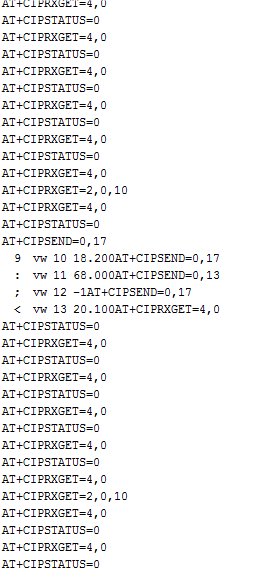To conclude the topic and in case anyone would like to turn the ArduFarmBot2 into GPRS connected I’m posting the changes I made to the project.
1/ To free GPIO9 and 10 (according to some using GPIO9 is questionable) flash your ESP8266 with the latest firmware in DIO mode.
2/ replace the main code with this one:
/***************************************************************************************************************
* ArduFarmBot using NodeMCU ESP-12 Develop Kit V1.0
* DHT connected to NodeMCU pin D3 (Ambient Temperature and Relative Humidity)
* Soil Moister Sensor connected to A0
* Sensor Data on local OLED Display
* Local Command via buttons
* OLED Display is off as default. Press Sensor Button to update and display data
* Introduced the function "waitButtonPress (int waitTime)", to break initial loop
* Automatic Local Control
* Display automatic set-up parameters at Start-up
* Sensor data sent to Blynk app
* Control commands received from Blynk app
* Downloads, docs, tutorials: http://www.blynk.cc
* Blynk library is licensed under MIT license
*
* MJRoBot Version 3.0 - Automatic and Remote Control Developed by MJRovai 16 Feb 2017
********************************************************************************************************************************/
#define SW_VERSION " SW Ver. 3.1" // SW version will appears at innitial LCD Display
#include "stationDefines.h" // Project definitions
#include "stationCredentials.h"
/* ESP & Blynk */
#define BLYNK_PRINT Serial // Comment this out to disable prints and save space
// Select your modem:
//#define TINY_GSM_MODEM_SIM800
#define TINY_GSM_MODEM_SIM900
//#define TINY_GSM_MODEM_M590
//#define TINY_GSM_MODEM_A6
//#define TINY_GSM_MODEM_A7
//#define TINY_GSM_MODEM_BG96
//#define TINY_GSM_MODEM_XBEE
// Default heartbeat interval for GSM is 60
// If you want override this value, uncomment and set this option:
// #define BLYNK_HEARTBEAT 8
#include <TinyGsmClient.h>
#include <BlynkSimpleTinyGSM.h>
#define SerialAT Serial
TinyGsm modem(SerialAT);
WidgetLED PUMPs(V0); // Echo signal to Sensors Tab at Blynk App
WidgetLED PUMPa(V5); // Echo signal to Actuators Tab at Blynk App
WidgetLED LAMPs(V1); // Echo signal to Sensors Tab at Blynk App
WidgetLED LAMPa(V6); // Echo signal to Actuators Tab at Blynk App
/* TIMER */
#include "SimpleTimer.h"
SimpleTimer timer;
/* OLED */
#include <ACROBOTIC_SSD1306.h> // library for OLED: SCL ==> D1; SDA ==> D2
#include <Wire.h>
/* DHT22*/
#include "DHT.h"
DHT dht(DHTPIN, DHTTYPE);
/* DS18B20 Temperature Sensor */
#include <OneWire.h>
#include <DallasTemperature.h>
OneWire oneWire(ONE_WIRE_BUS);
DallasTemperature DS18B20(&oneWire);
void setup()
{
Serial.begin(115200);
delay(10);
Serial.println("ArduFarmBot 2");
Serial.println(".... Starting Setup");
Serial.println(" ");
SerialAT.begin(115200);
delay(3000);
// Restart takes quite some time
// To skip it, call init() instead of restart()
Serial.println("Initializing modem...");
modem.init();
pinMode(PUMP_PIN, OUTPUT);
pinMode(LAMP_PIN, OUTPUT);
pinMode(PUMP_ON_BUTTON, INPUT_PULLUP);
pinMode(LAMP_ON_BUTTON, INPUT_PULLUP);
pinMode(SENSORS_READ_BUTTON, INPUT_PULLUP);
pinMode(soilMoisterVcc, OUTPUT);
Blynk.begin(auth, modem, apn, user, pass);
oledStart();
dht.begin();
DS18B20.begin();
PUMPs.off();
LAMPs.off();
PUMPa.off();
LAMPa.off();
digitalWrite(PUMP_PIN, LOW);
digitalWrite(LAMP_PIN, LOW);
digitalWrite (soilMoisterVcc, LOW);
waitButtonPress (SHOW_SET_UP); // Wait for Sensor Button to be pressed
oled.clearDisplay();
startTimers();
}
void loop()
{
timer.run(); // Initiates SimpleTimer
Blynk.run();
}
/****************************************************************
* Read remote commands
****************************************************************/
BLYNK_WRITE(3) // Pump remote control
{
int i=param.asInt();
if (i==1)
{
pumpStatus = !pumpStatus;
aplyCmd();
}
}
BLYNK_WRITE(4) // Lamp remote control
{
int i=param.asInt();
if (i==1)
{
lampStatus = !lampStatus;
aplyCmd();
}
}
/****************************************************************
* Read local commands (Pump and Lamp buttons are normally "HIGH"):
****************************************************************/
void readLocalCmd()
{
boolean digiValue = debounce(PUMP_ON_BUTTON);
if (!digiValue)
{
pumpStatus = !pumpStatus;
aplyCmd();
}
digiValue = debounce(LAMP_ON_BUTTON);
if (!digiValue)
{
lampStatus = !lampStatus;
aplyCmd();
}
digiValue = debounce(SENSORS_READ_BUTTON);
if (!digiValue)
{
turnOffOLED = !turnOffOLED;
if (!turnOffOLED)
{
oled.setTextXY(0,0); oled.putString("UPDATING SENSORS");
getDhtData();
getSoilMoisterData();
getSoilTempData();
oledStart();
displayData();
}else oled.clearDisplay();
}
}
/***************************************************
* Receive Commands and act on actuators
****************************************************/
void aplyCmd()
{
if (pumpStatus == 1)
{
Blynk.notify("ArduFarmBot2: Warning ==>> Pump ON");
digitalWrite(PUMP_PIN, HIGH);
if (!turnOffOLED) displayData();
PUMPs.on();
PUMPa.on();
}
else
{
digitalWrite(PUMP_PIN, LOW);
if (!turnOffOLED) displayData();
PUMPs.off();
PUMPa.off();
}
if (lampStatus == 1)
{
Blynk.notify("ArduFarmBot2: Warning ==>> Lamp ON");
digitalWrite(LAMP_PIN, HIGH);
if (!turnOffOLED) displayData();
LAMPs.on();
LAMPa.on();
}
else
{
digitalWrite(LAMP_PIN, LOW);
if (!turnOffOLED) displayData();
LAMPs.off();
LAMPa.off();
}
}
/***************************************************
* Automatically Control the Plantation based on sensors reading
****************************************************/
void autoControlPlantation(void)
{
if (soilMoister < DRY_SOIL)
{
turnPumpOn();
}
if (airTemp < COLD_TEMP)
{
turnLampOn();
}
}
/***************************************************
* Turn Pump On for a certain amount of time
****************************************************/
void turnPumpOn()
{
pumpStatus = 1;
aplyCmd();
delay (TIME_PUMP_ON*1000);
pumpStatus = 0;
aplyCmd();
}
/***************************************************
* Turn Lamp On for a certain amount of time
****************************************************/
void turnLampOn()
{
lampStatus = 1;
aplyCmd();
delay (TIME_LAMP_ON*1000);
lampStatus = 0;
aplyCmd();
}
/***************************************************
* Send data to Blynk
**************************************************/
void sendUptime()
{
Blynk.virtualWrite(10, airTemp); //virtual pin V10
Blynk.virtualWrite(11, airHum); // virtual pin V11
Blynk.virtualWrite(12, soilMoister); // virtual pin V12
Blynk.virtualWrite(13, soilTemp); //virtual pin V13
}
3/ Unlock your SIM card with your phone and replace stationCredentials with this:
char auth[] = "Your Blynk auth token"; // Blynk project: "ArduFarmBot2"
char apn[] = "Your APN";
char user[] = "";
char pass[] = "";
4/ In stationDefines (bottom) redirect buttons to free up Tx/Rx by replacing the last 3 lines with this:
/* Buttons */
#define PUMP_ON_BUTTON 10 //push-button PUMP (Red) D9 to SD3
#define LAMP_ON_BUTTON D0 //push-button LAMP (Green) D10 to D0
#define SENSORS_READ_BUTTON D4 //push-button SENSOR (yellow)
5/ Although not critical for this project to prevent interruptions consider disabling the notifications by deleting the Blynk.notify lines in the main code.
6/ Instead of resistive I’m using a capacitive sensor which is not prone to corrosion and wear and tear. Calibrate yours and in getSensors change the values accordingly:
soilMoister = map(soilMoister, 822, 403, 0, 100); //capacitive sensor v1.2
7/ Instead of LAMP I intend to use a linear motor to open a vent to prevent greenhouse from overheating.
Enjoy!

